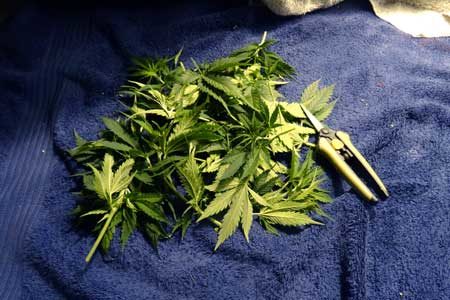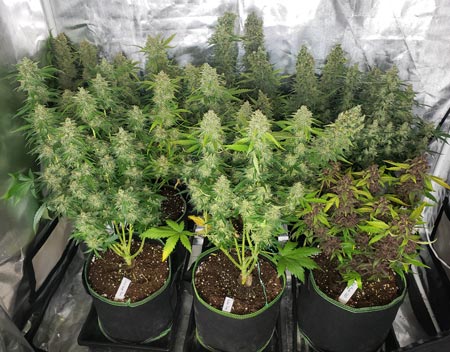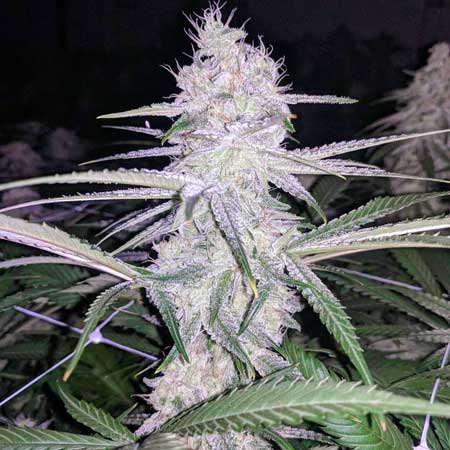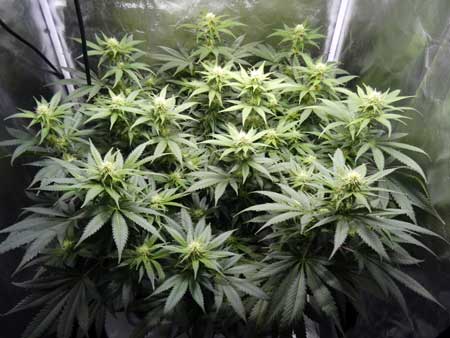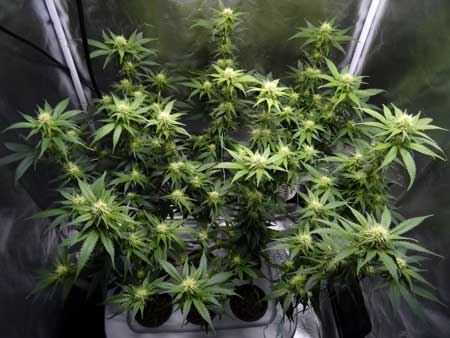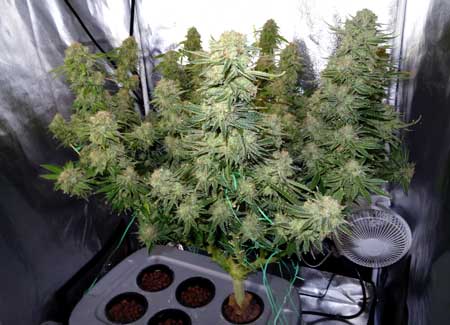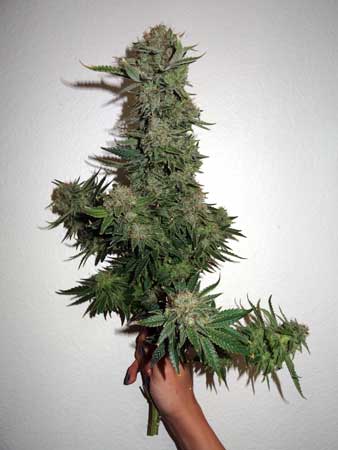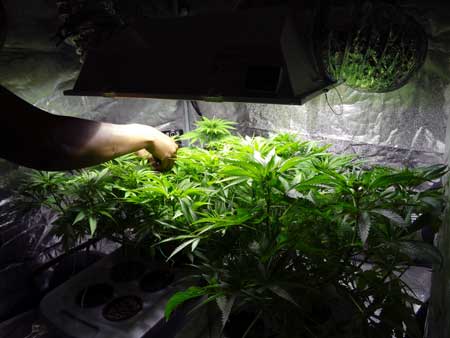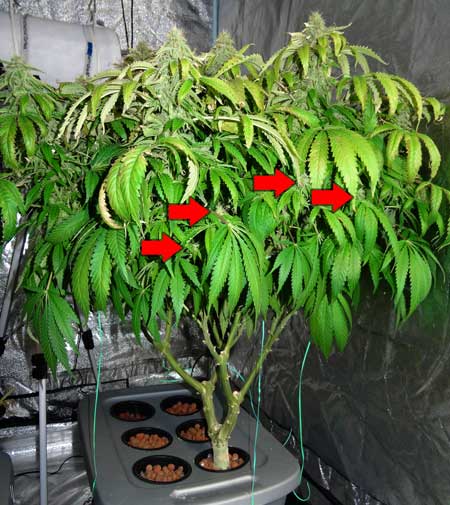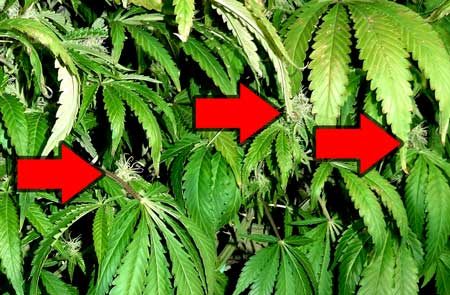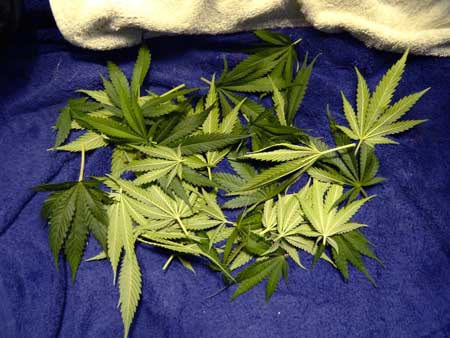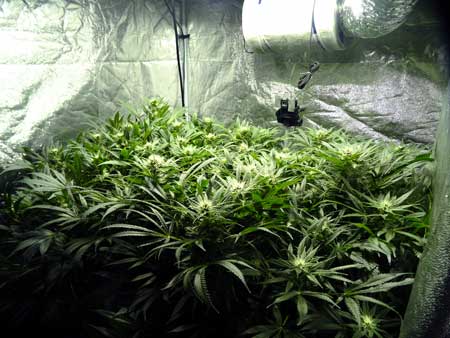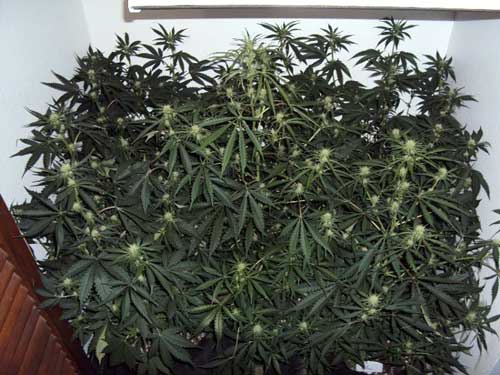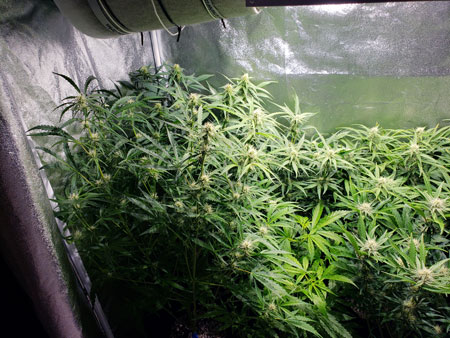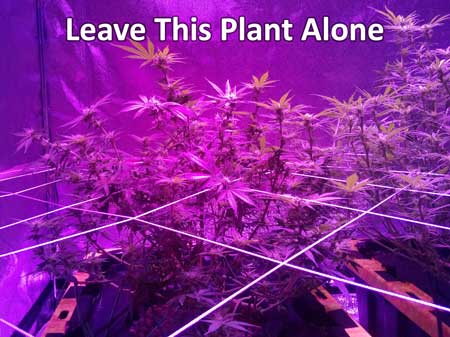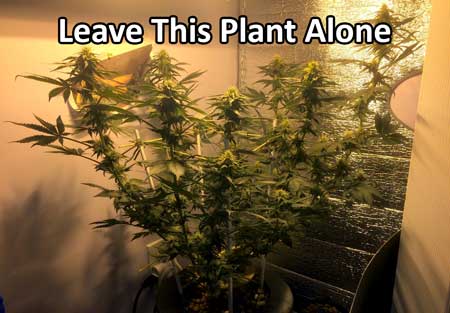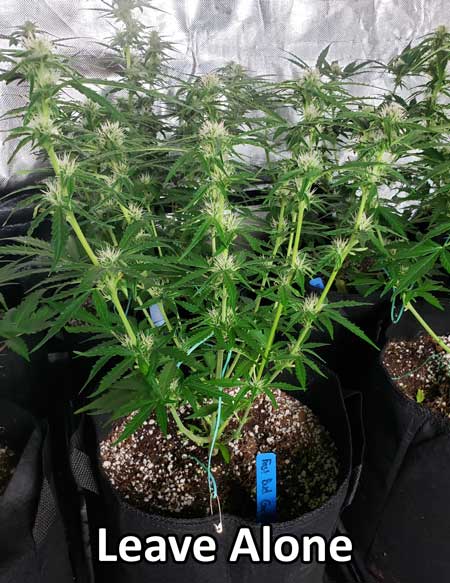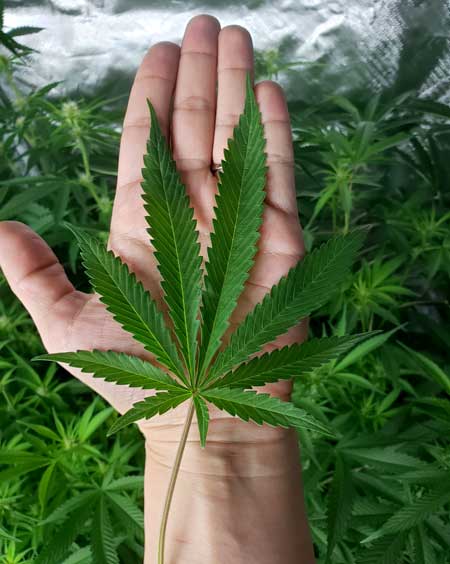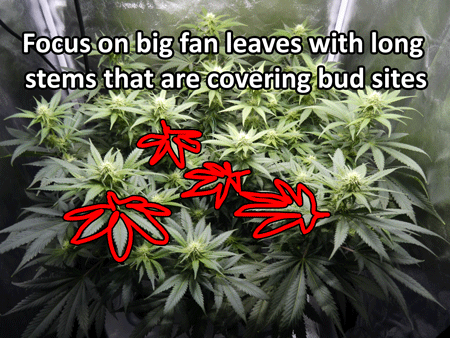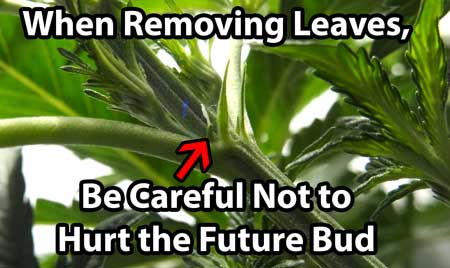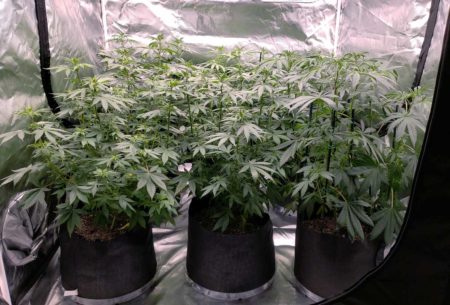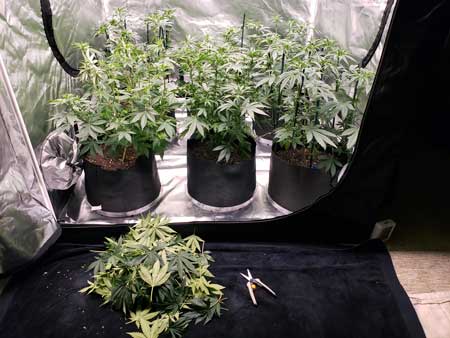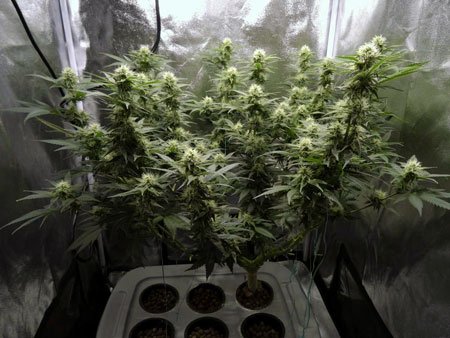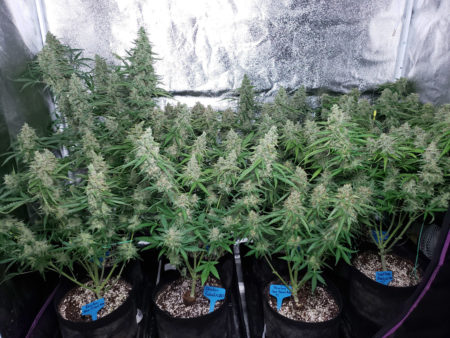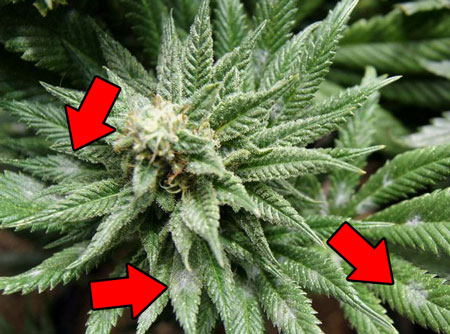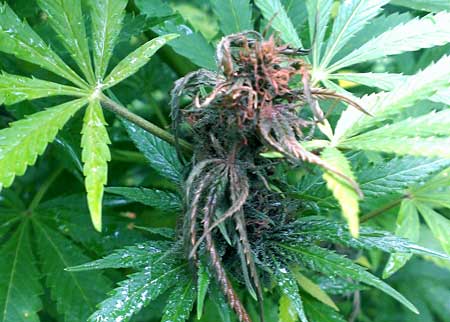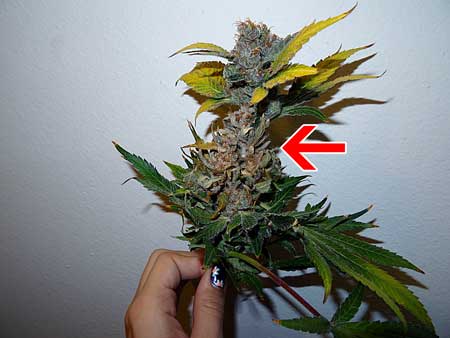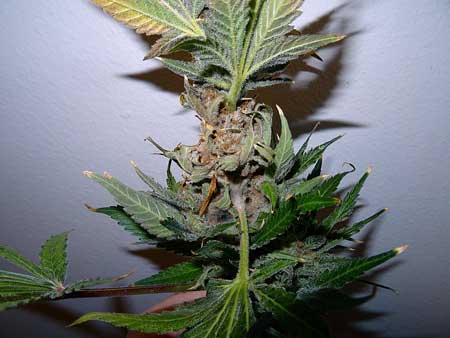by Nebula Haze
Defoliation means strategically removing leaves from your cannabis plant.
I’ve already published a few cannabis defoliation tutorials, but this one is different. It’s designed to make defoliation as easy and fool-proof as possible. You can use the following technique on ANY plant in any setup, including autoflowering strains. Note: This tutorial is only for defoliation in the flowering stage. Check out our main defoliation page to learn when defoliation is appropriate in the vegetative stage.
When done properly in the flowering stage, strategic defoliation forces cannabis plants to grow long dense buds.
What cannabis defoliation does if you follow the instructions in this tutorial:
- Healthier plants – Defoliation helps reduce the chance of bud rot or white powdery mildew on a plant that tends to grow bushy. This tutorial shows you what plants look like when defoliation is going to be helpful, and when it’s better to leave your plant alone.
- Lower humidity – Since each leaf is continually adding water vapor to the air, defoliation decreases the overall humidity of a grow space. That could be a good or bad thing depending on your local environment, but it’s common for growers to struggle with high humidity in the grow space once plants start getting big with tons of leaves.
- Better airflow within the plant – Lack of airflow is associated with problems like mold and pests. Air doesn’t travel well through a bushy plant.
- Denser buds – If you follow the instructions as written, defoliation reduces the number of small, airy buds which typically get thrown into the trim pile after harvest. Many growers prefer big dense nugs over tons of tiny, wispy nugs. In my experience, defoliation helps ensure all buds at harvest are weighty and thick.
- Longer primary buds – With very bushy plants, buds may only be an inch or two long. Proper defoliation allows light to penetrate further down into the plant, and buds are typically longer as a result. Who doesn’t want foot-long colas?
Here’s a quick cannabis defoliation example to give you an idea of the whole process:
This plant is at week 3 of the flowering stage (3 weeks of a 12/12 light schedule). Light and air are not getting into the plant.
Post-defoliation – never defoliate more than this unless you already have experience with defoliation
The plant was left alone after that. Here is the result at harvest
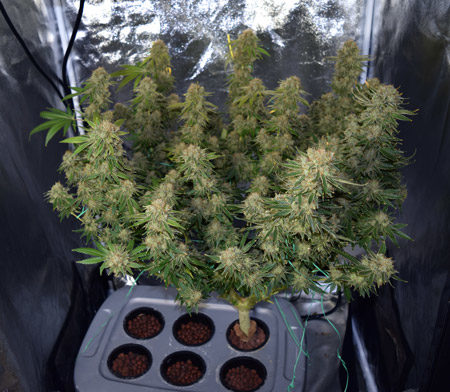
And lots of huge ones
Defoliation is effective at making longer, denser buds that you would get if plants were left alone in the flowering stage. However, defoliation doesn’t always increase yields. Defoliation increases yields when done in a specific way, but removing leaves can reduce overall yields in certain setups and situations. Let me help you decide if defoliation will decrease or increase yields.
Will cannabis defoliation increase yields?
- Defoliation is most effective with nutrients – Cannabis plants respond best to defoliation when they’re getting extra nutrients in the water. Each leaf holds nutrients and defoliation removes these nutrients from the plant’s stores. When growers don’t add extra nutrients in the water (such as in a “just add water” super soil grow) the plant roots are forced to do extra work to get more nutrients out of the soil. This extra work can slow the plant down during key stages of bud development, which may prevent buds from getting as big as they could have. On the other hand, mineral nutrients in the water are absorbed quickly and are immediately available to the plant. If you’re not adding nutrients to the water, be extra careful not to go overboard and strip your plant.
- Fast-growing plants respond best – Fast-growing and tall plants tend to respond better than slow-growing or short plants.
- Don’t take too many leaves at once – Taking too many leaves at once can sometimes stunt a plant, which reduces yields.
Even in cases where yields are slightly reduced, if you follow the instructions below to a T, your plants will produce longer, denser buds with beautiful structure. Keep reading to learn how!
These plants are so bushy that light and air can’t penetrate below the top canopy. Without defoliation to expose the bud sites, buds likely won’t fatten properly or get dense. This is because shadows and lack of air movement prevent buds from developing properly.
How does defoliation work? There is a lot of debate on the actual mechanism that’s causing the changes people see from defoliating their plants. This defoliation article goes into the theories, but today I’m focused purely on the practical application and showing picture-proof so you can decide for yourself if it seems like something you want to do in your garden.
What’s the Big Deal with Bushy Plants?
Plants with too many leaves for their size often raise the humidity of the grow space above appropriate levels. High humidity often triggers problems such as:
- mold or mildew
- bud rot
- pests
- poor bud development
No one wants any of that.
Buds that are hiding in the shadows stay small and airy. The following plant was manifolded (notice the base), which usually helps prevent airy buds, but the plant was never defoliated in the flowering stage. Although the top few inches of buds thickened up beautifully, every bud that grew below the thick canopy stayed small.
Check out the buds that didn’t get light or air in the flowering stage. You can barely see them they’re so small.
All the hidden buds became tiny wisps of white hairs with no substance (this is a closeup of the same picture).
Proper flowering stage defoliation reduces the number of tiny buds getting thrown into the trim pile, so all the buds you do harvest are more likely to be thick and chunky.
Learn more about the problems associated with too-bushy plants
How to Defoliate Plants in the Flowering Stage (with No Chance of Stunting)
Warning: Defoliation can hurt yields when done incorrectly. It’s essential to follow these steps exactly (especially when NOT to defoliate), to ensure you never experience stunting or reduced yields.
As long as you follow the 3 steps as written, you won’t take any risks and your harvest will reward you with thick dense nugs.
Ready to start defoliating?
1.) Identify IF your flowering plant is too leafy
Plants often “bush out” after they start flowering. Not all strains, and not in all setups, but it’s common. Especially if you’re growing happy, vibrant plants with added nutrients in the water. A lot of new defoliators get confused with when to defoliate and defoliation schedules. When is defoliation is a good idea? When will defoliation make things worse?
Defoliate when…
- Plants are growing fast and healthy
- The plant is so bushy that light and air can’t get through
- Leaves are laying on top of each other forming wet spots
- Leaves are covering bud sites and can’t be tucked away
- Plants are still in the first 6 weeks of the flowering stage
But what does “too bushy” look like?
These plants would benefit from a good plucking!
These plants are too bushy and should be defoliated
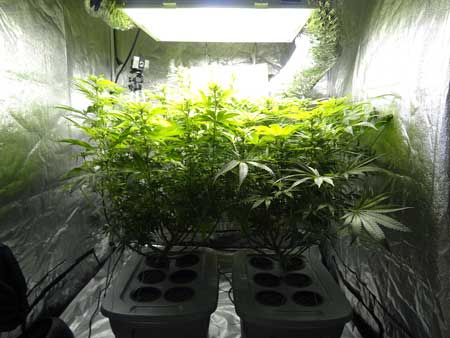
These plants are only a few weeks into the flowering stage. Light and air are not getting into the plant. Defoliate!
When Not to Defoliation Cannabis Plants
Do NOT Defoliate When…
- The plant is not leafy – defoliating a sparse plant will usually stunt growth
- It’s past the first 6 weeks of the flowering stage – defoliation is much less effective once bud structure is set and plants have stopped growing many new leaves.
The most common beginner mistake is to defoliate a plant that’s not bushy, to over-defoliate, or defoliate too late in the flowering stage. This can stunt plant growth and reduce yields. So the most critical aspect of defoliation is being able to determine when the plant has too many leaves and when it needs to be left alone.
These plants are not too bushy. Leave these plants alone!
Ok, now you should have identified whether your plants are too bushy. Do not defoliate if you’re not sure. Wait and see. If you feel confident that you’ve got too-bushy plants, onto the next step.
2.) Remove big fan leaves if the plant is too leafy
Whenever defoliating, focus on removing big fan leaves with long stems. These leaves cause the most shade and stick out from buds, causing a thick canopy that can’t be penetrated by light or air. Focusing only on the biggest leaves reduces the chance you’ll stress out your plant. It’s also smart to remove leaves that are blocking bud sites (and can’t be tucked) or leaves that are laying on each other creating wet spots.
Which leaves to defoliate?
- Big fan leaves on long stems
- Fan leaves that are blocking bud sites (especially leaves at the top of the plant that can’t be tucked away)
- Fan leaves laying on each other creating wet spots
Remove leaves big fan leaves with long stems
Focus on leaves that are blocking bud sites from receiving direct light or airflow. Especially if the leaf is directly between the bud site and your grow light, or buds are not getting airflow.
Examples of fan leaves that are good candidates for removal
There should still be plenty of leaves left after defoliation. Taking too many leaves so that your plant is bare will often stunt the plant’s growth. When in doubt, take less than you think. You can always take more leaves tomorrow, but you can’t put leaves back.
Before defoliation
After defoliation (this is on the lighter side)
After defoliation, there should still be leaves along each branch. Only the biggest fan leaves should be removed.
This example is on the more extreme side of defoliation. Some growers take even more leaves, but I would never suggest a beginner defoliate more than this.
3.) Leave plant alone (unless it gets too bushy again, then back to Step 1)
Once a plant has been defoliated, it should receive TLC (tender loving care) and otherwise should be left alone so it can do its thing. Only defoliate again if it starts looking bushy like the examples in Step 1.
Just remember that you don’t want to be taking leaves after the plant has stopped growing new ones. Try to finish all defoliation before the plant has been flowering for 6 weeks unless you have to (for example, you see wet spots on the leaves).
Let plants do their thing until harvest!
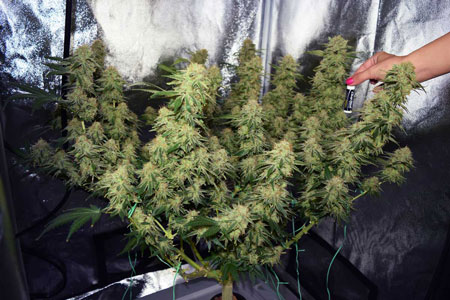
Buds are visible from top to bottom as buds form
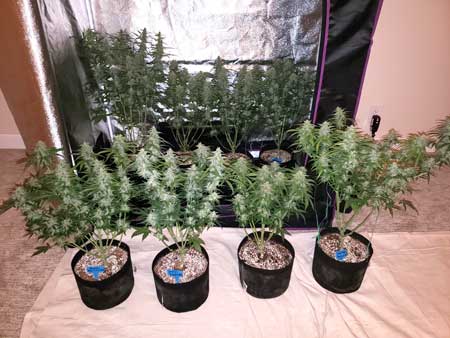
Now you have all the info you need to become a great defoliator! You don’t need to use any particular schedules. As long as you follow the 3-step process outlined above, you won’t stunt your plants, while still getting the benefits of defoliation.
I want a more specific defoliation schedule (we’ve got you covered!)
More Info: Why are Leafy Plants Such a Problem?
Beyond the debate about bud quality and yields, there are other reasons to defoliate. When most of a plant is in the dark as a result of too many leaves, air usually can’t get through the plant either.
No matter the stage of life, your plant can get white powdery mildew (mold that looks like flour) from wet spots and high humidity
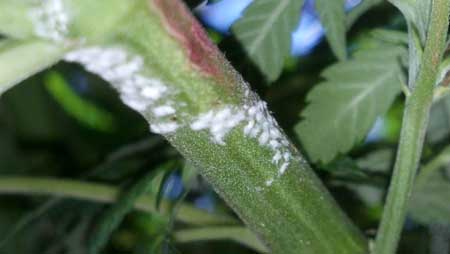
In the flowering stage, defoliation may be necessary to prevent harm to your buds.
Wet spots are dangerous to buds because they increase the chance of bud rot
In the following picture, the left plant is too bushy. You can tell that air doesn’t seem to have a path through the plant because most of the plant is in darkness even though the light is a strong 600W HPS, which normally pierces deep into the plant. There are tons of leaves lying on each other on the left plant. As you get closer, you’ll see that there are wet spots between the leaves that are touching. Wet spots are dangerous to buds.
This left plant is too bushy, putting it at risk of wet spots and bud rot. The right plant allows air to travel through the plant.
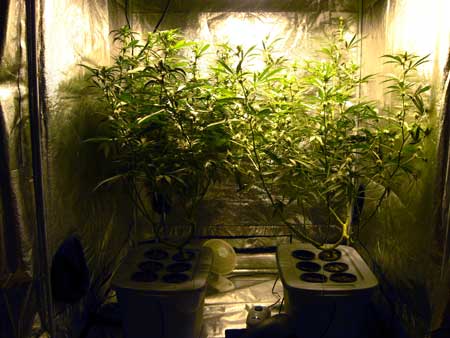
The first sign of bud rot is usually sick leaves appearing on affected buds.
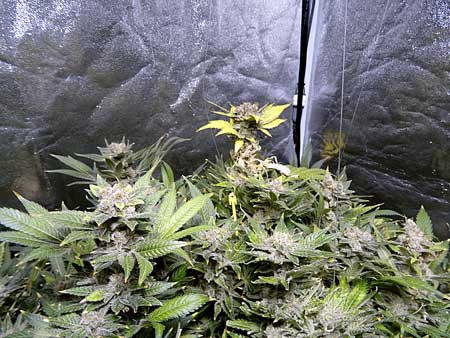
The bud usually splits open easily open to reveal the mold and rot inside
Be extra aware of high humidity, wet spots, and leafy plants when buds are getting fat and dense. Learn more.

